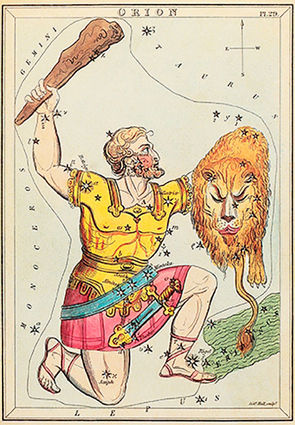Gould's Belt defines our galactic neighborhood
Sky Watch: Keeping an eye above the horizon

"It takes a lot of imagination to see all of this in the stars, but this is how Jehosaphat Aspin of London saw it in 1825."
The warm winter we've been enjoying has also afforded us many extra nights of skies clear enough to see the Milky Way. Most consider the section of our galaxy that's in view on winter evenings to be the most beautiful. Indeed, Orion is almost universally acclaimed as the most beautiful constellation of all. Its iconic belt of three bright stars suspends a dazzling sword of new born stars set against a maelstrom of bright and dark nebulae. Four bright stars define Orion's shoulders and feet, while a knot of stars represents his head. To his left is Sirius, the brightest star in night sky....
But, wait! The Great Orion Nebula is a good 20º above the plane of the Milky Way. Would it be that we could trade places! From that vantage point, (assuming we had a clear view) we would be able to see out across the vast expanse of the entire galactic disc! Unfortunately, from where we sit on the galactic plane (right on the playing field, as it were), we can only see our local neighborhood and a few tantalizing glimpses through pinprick holes in the great galactic dust clouds.
So, if Orion isn't part of the vast plane of the Milky Way, what is it? It's the most dazzling part of a gigantic bubble that defines our galactic neighborhood. We call it Gould's Belt.
Orion isn't the only bright constellation that seems to be out of place. In fact, you can trace a circle around the sky that is canted about 17º to the galactic plane. It includes such familiar features as the constellations Taurus and Perseus, and the stars Vega and Antares. It turns out that these features are part of a "belt" that helps to define the foreground of our local spiral arm of the galaxy.
The first to notice this belt was the venerable 19th century English astronomer John Herschel, but ended up being named after American astronomer Benjamin Gould. Precisely how and when the belt was created is still officially considered "unknown," but considerable thought and research is still ongoing. Here's my general interpretation of the current thinking.
Some 30 to 70 million years ago, a blob of dark matter slammed into a rich molecular cloud in this part of the galaxy. This caused the formation of huge, hot O- and B-type supergiant stars on a colossal scale. As they ended their short, intense lives, they exploded as supernovae and even hypernovae. This had the effect of blowing the entire cloud apart over just a few million years.
We've learned that such enormous explosions do not expend their energies symmetrically in all directions. Most often, there are powerful jets in opposite directions with a ring of ejected material at right angles to the jets. This is why George Lucas and company added these dazzling effects to the explosion of the Death Star when they updated the original Star Wars films.
It would appear that Gould's Belt is the remnant ring of such an explosion. It seems that we are living only a few hundred light-years from the center of what could well be called Gould's Bubble, a region that is humanity's immediate galactic neighborhood.
The bubble is about three thousand light-years across. Its center is near the Alpha Persei Cluster of O- and B-type supergiant stars about 600 light-years away. That puts us about half-way between the center and the bubble's edge. That's part of what makes this area of space so quiet and particularly conducive to the development of life.
The expanding surface of the bubble includes the Great Orion Nebula at a distance of 1500 light-years. These and other rich dust clouds of Gould's Belt are the ideal subjects for studying star formation. American and Canadian researchers are using Spitzer Space Telescope data, as well as the James Clerk Maxwell Telescope and the Herschel Space Telescope, to completely characterize the molecular clouds and associated young stars within Gould's Belt. Their efforts should lead to far greater understanding of how stars are created.
So, go out tonight and look at Orion with fresh eyes and an eager spirit. It may take us millions of years to do it, but as we gradually reach for the stars, exploring and colonizing the confines of this bubble appears to be our destiny.
Is it too soon to broadcast an interstellar message staking out Gould's Bubble as the First Terran Empire? Well, probably; we're certainly in no position to defend it, yet!
Daylight Savings Time returns on Sunday, March 8th, at 2 a.m. Remember to "spring those clocks forward." Spring officially returns with the Vernal Equinox on March 20th at 3:45 p.m.
The Zodiacal Light will still be visible in the evening to the west as a huge column of diffuse light reaching up from the horizon and sloping to the left.
Venus and Mars continue to shine in the evening twilight, although Mars will sink rapidly as March progresses. However, Uranus will pass only 0.09º from Venus on March 4th. Can you find it? (Hint: You'll need at least binoculars and a star chart, and it helps to edge Venus out of your field of view, because it's 10,000 times brighter than Uranus!)
Jupiter still rules the night. However, Saturn rises around midnight with its rings still wide open. The best time is just before dawn when it's high in the south and the air is cool and still.
Sunrise: 6:23 a.m./Sunset: 5:49 p.m. PST (March 1st)
Is there a topic you'd like to see covered in Sky Watch? Did you catch a slip-up? Did I touch a tender spot? Send me your thoughts at hawk@ieee.org.




